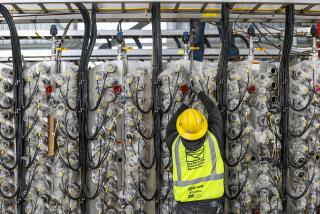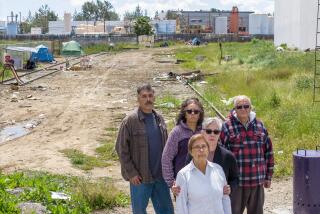Westinghouse Promotes Its A-Waste Cleanup : Environment: But a watchdog group says the claims about cleaning up billions of gallons of radioactive debris at Hanford nuclear site are exaggerated.
- Share via
RICHLAND, Wash. — Think of the nation’s most polluted nuclear weapons production site. Now think of two pretty little girls in long dresses picking wildflowers there.
Under the slogan: “It’s the nature of our business,” the Westinghouse Hanford Co. is trying to change perceptions of the job it is doing at the Hanford nuclear reservation, created during the World War II Manhattan Project to make plutonium for development of the atomic bomb.
The 30-year task of cleaning up billions of gallons of radioactive waste--one of the nation’s largest public works projects--is just starting.
Westinghouse and the U. S. Department of Energy, owner of the Hanford site, want to make sure the estimated $50 billion needed keeps flowing from Congress.
Westinghouse is holding briefings for reporters and seminars that offer opportunities for cleanup business for western Washington companies.
“It’s important for the people in the Northwest to understand that Hanford is doing a good job of reducing liquid discharges to the soil,” spokesman Mike Berriochoa said. “That message has not gotten out.”
Westinghouse also is struggling to retain the major portion of the environmental restoration and cleanup work at Hanford.
Energy Secretary James D. Watkins is seeking to hire an environmental restoration and management contractor at the site. The Washington congressional delegation has fought this, contending that it would disrupt the area economy by ousting stable union jobs and replacing them with specialists retained to do specific tasks.
The government proposal has run into trouble in the Senate and may be delayed a year.
Recently, Westinghouse said it had made significant progress in shutting down 33 “waste streams” that had dumped nuclear and hazardous wastes into the soil.
Of the 33 waste streams identified as problem sites in 1987, 15 have been reduced by 99% to 100%, Westinghouse said. Only nine have been cut by less than half.
“To shut those streams now would cause environmental problems far worse than leaving them running,” because the streams are needed to provide cooling water and other essential services, Berriochoa said.
But Gerald Pollet of the watchdog group Heart of America Northwest said such claims are lies.
The Seattle-based group is suing the government to stop the discharges immediately. Pollet estimates the discharges to run to 1 billion gallons per year. The government and Westinghouse are just trying to avoid building expensive treatment plants for outdated facilities, Pollet said.
Berriochoa refused to discuss the lawsuit.
June Hennig, director of Hanford waste management for the U. S. Department of Energy, said the government is satisfied with Westinghouse’s progress in shutting down the waste streams.
The company has met all the milestones in the landmark 1989 cleanup agreement, she said.
State regulators are also satisfied with the cleanup progress, said Tom Tedd of the Washington state Department of Ecology.
Pollet also complained that the advertisement showing the little girls implies that it would be safe to pick flowers on the reservation.
“If they romped around in the Hanford Reach of the Columbia River they would get their annual exposure (of radiation) in 40 hours,” he said.
Much of the 560-square-mile reservation is uncontaminated, although a small portion contains the nation’s greatest collection of radioactive waste.
Hanford no longer makes plutonium for nuclear weapons, but many of its processing plants are functional and must be maintained until they are closed for good.
Donald E. Kelley, manager of effluent treatment programs on the site, said two treatment facilities will be built by 1994 to handle the remaining waste streams. All untreated waste streams are to be closed by 1997.
“After treatment the fluid will be pure water to dispose of,” he said.
Total investment in closing the waste streams should be about $300 million by 1997, said W. H. Hamilton, manager of waste remediation.
More to Read
Sign up for Essential California
The most important California stories and recommendations in your inbox every morning.
You may occasionally receive promotional content from the Los Angeles Times.













